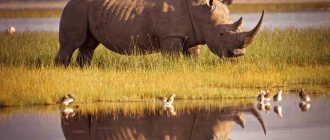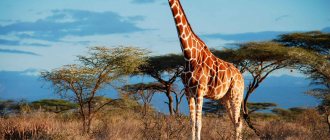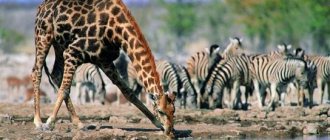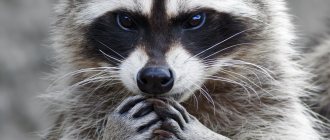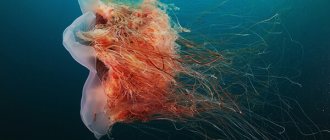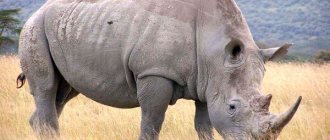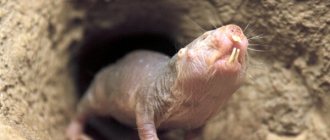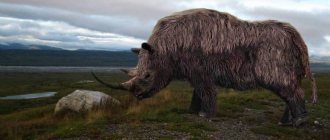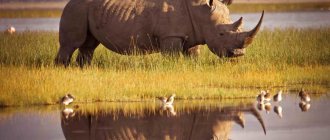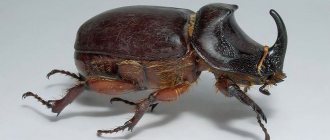№7
In fact, both white and black rhinoceroses have the same color - grayish-brown. Scientists still don’t know why “white” got its name. One theory is that the Dutch colonialists in Africa nicknamed white rhinoceroses wijd, meaning “broad.” By the word “wide” they meant the wide mouth of the animal.
This word was adopted by the English to mean "white", which is how it got its modern name.
Black got its name so that it could be distinguished from white.
Rhinoceros: description
Modern rhinoceroses are quite easily distinguished from other species of animals by the presence of a horn in the nose area. The number of horns is not limited to one, so there may be several of them, depending on the species. The anterior horn is usually a continuation of the nasal bone, and the second horn may grow from the frontal part of the animal's skull. In fact, the horns are not formed from the bone tissue of the animal, but represent a concentration of keratin. The length of the largest horn was within 158 centimeters, which is officially documented.
It is important to know! This species of animal appeared on our Planet about several million years ago, while experts note the fact that many fossil species of rhinoceroses were deprived of the main feature - the presence of a horn in the nasal area.
In addition to having horns, rhinoceroses have a fairly massive body, as well as short (comparatively) but thick limbs. Each limb ends in a broad hoof, as well as three toes. The body of the animal is covered with thick skin, the color of which is made in brownish tones. Species living in the vast expanses of Asia are characterized by the fact that the thick skin in the leg area, as well as in the neck area, is collected in characteristic folds, which has the appearance of covering armor. Rhinoceroses, regardless of species, do not have very good eyesight, but the animal has excellent hearing and a fairly sensitive sense of smell.
Rhinoceros - interesting facts
Appearance
Characteristic differences between animals belonging to a certain species:
Black rhinoceros
Black rhinoceroses are considered quite powerful and large animals, weighing just over 2 thousand kilograms. The height of the black rhinoceros is about one and a half meters, with a body length of about 3 meters. This is an animal with two horns, the length of which is within 0.6 meters or more. At the base, these horns are round in shape.
White rhinoceros
White rhinoceroses are simply huge mammals that weigh almost 5 thousand kilograms, and their body length is within 4 meters. The height of these monsters reaches almost 2 meters. The main color of the skin is slate gray. This species is also characterized by the presence of a flat upper lip, which is also wide (comparatively). This allows the mammal to feed on a variety of vegetation.
Indian rhinoceros
Indian rhinoceroses are massive animals, with a body weight of 2 thousand kilograms or more. The height of males reaches 2 meters. The skin hangs down, but is not covered with hair, the color of which is grayish-pink. The presence of folds creates the appearance of division of the skin into separate fragments. On thick skin you can see swellings in the form of bumps. Separate fragments of fur grow in the form of tassels on the ears and tail. There are also folds of skin on the neck, although not significant. In the area of the ears, as well as at the end of the tail, a lump formed by hairs is clearly visible.
Sumatran rhinoceros
Sumatran rhinoceroses reach almost one and a half meters in height, with a body length ranging from 2.5 to 3 meters or a little more. Such animals weigh from 0.8 to 2 thousand kilograms. Representatives of the species are distinguished by the presence of a front horn, no more than 15 centimeters long, as well as a second horn, about 10 centimeters long, the color of which can be black or dark gray. The folds in the skin begin from the forelimbs and continue to the hind limbs. There are also folds in the neck area, but not many.
Javan rhinoceros
Javan rhinoceroses have some similarities with Indian rhinoceroses, although they are not as impressive in size. The body length is on average 3 meters, and the height of the animal at the withers is on average one and a half meters. This species of rhinoceros has only one horn, the length of which is within 20 cm or a little more. Females do not have a horn as such, but in its place there is a knob-like growth. The skin is completely bare, brown-gray in color. Folds can be seen in the back, in the shoulder area, and also in the croup area.
Interesting moment! Rhinos have no fur, almost completely, with the exception of the tip of the tail and the ear area. A distinctive feature of the Sumatran rhinoceros is the presence of rare brown hair on their body.
The Black and White rhinoceros species do not have incisors, but the Indian and Sumatran rhinoceros species have tusks. It should be noted that all 5 species have molars, both on the lower and upper jaws, in the amount of 3 pieces.
Character and lifestyle
Black rhinoceroses are characterized by a very peaceful nature when communicating with each other. Although they organize fights, these fights are more of a symbolic nature. Representatives of this species do not have a complex set of vocal data. Adults make loud sounds reminiscent of a normal snort, and in case of danger the animal whistles sharply and piercingly.
White rhinoceroses prefer to stay in groups of up to one and a half dozen individuals. Adult males quite often arrange fights, as a result of which one of the males can say goodbye to life. Each adult male has his own territory, which he marks in various ways. When it is hot and sunny during the day, these animals prefer to spend time in the shade of various vegetation and leave their shelters only in the dark, after the onset of coolness.
Indian rhinoceroses, due to their massiveness, are considered sedentary animals, but this is not at all true, since they have excellent reaction and mobility. In case of real danger, these animals are capable of accelerating up to 40 km/h. Under favorable wind conditions, rhinos can sense danger several hundred meters away.
Sumatran rhinoceroses lead a mostly solitary lifestyle and form groups only during periods of mating and raising young offspring. According to experts, Sumatran rhinoceroses lead the most active lifestyle when compared with other types of rhinoceroses. Each adult has its own territory, the boundaries of which are marked with excrement, as well as with the help of fallen or broken vegetation.
Interesting to know! African rhinoceroses have a symbiotic relationship with buffalo starlings. These birds monitor the cleanliness of the skin of these animals, destroying various ectoparasites. In addition, starlings notify these animals of possible danger. The same connections exist among Indian rhinoceroses, which coexist peacefully with some bird species.
Javan rhinoceroses also prefer to lead a solitary lifestyle, so they can only be found in a group during breeding periods. Adults mark the boundaries of their territories using odorous marks or numerous scratches left by animals on vegetation or on the ground.
How long do rhinoceroses live?
Living in the wild, such animals live no more than 3 decades, although in captivity they can live longer. In any case, these indicators depend on the species of mammals, as well as comfortable living conditions.
Sexual dimorphism
It is possible to distinguish a male from a female rhinoceros, since females are always smaller in size and have less body weight. In addition, females may lack a horn, and if they do have one, it is always smaller compared to the male’s horn.
Types of rhinoceroses with photos
The modern family "Rhinoceros" consists of two subfamilies and 61 genera (with 57 genera considered extinct). Scientists have studied 5 species of rhinoceroses well in our time. These types include:
Black rhinoceros (Diceros bicornis)
Black rhinoceroses are considered an African species, with four subspecies.
White rhinoceros (Ceratotherium simum)
White rhinoceroses are considered the largest representatives of the Rhinoceros family. They occupy 4th place in terms of their performance among the largest land animals living on our Planet.
Indian rhinoceros (Rhinoceros unicornis)
Indian rhinoceroses are considered the largest representatives among Asian modern rhinoceroses.
Sumatran rhinoceros (Dicerorhinus sumatrensis)
Sumatran rhinoceroses represent the only species of Sumatran rhinoceros extant today. This species consists of a western subspecies as well as an eastern subspecies.
Important fact! In no more than a quarter of a century, several species of animals living on our Planet have disappeared forever. It is a pity that the western black rhinoceros was among the extinct animals.
The Javan rhinoceros also belongs to the genus Indian rhinoceros, represented by three subspecies: standard, Vietnamese and mainland.
RHINO AGAINST hippopotamus, lion, elephant, buffalo, wild boar and even dinosaur! Rhino in ACTION!
Where do rhinoceroses live?
Black rhinoceroses have become perfectly accustomed to areas with little moisture, and they live in the same areas for years. The most numerous subspecies “D. Bicornis minor." The type subspecies has chosen the drier regions of the southwestern and northeastern habitat of countries such as Namibia, South Africa and Angola. The eastern subspecies is mainly found in Tanzania.
The habitat of White rhinoceroses is associated with two areas that are located at a significant distance from each other. The southern subspecies settled in the vastness of southern Africa, in Namibia, Mozambique and Zimbabwe. The northern subspecies is found in the northern as well as northeastern regions of countries such as the Democratic Republic of the Congo, as well as southern Sudan.
Indian rhinoceroses spend most of their lives in solitude in a specific territory that they protect. Similar animals can now be found in Pakistan, Nepal and Eastern India, with a small number of Indian rhinoceroses still remaining in the north of Bangladesh.
Only rare representatives of this family do not have their own territories, while the majority of species occupy individual territories of significant area. Indian rhinoceroses are considered excellent swimmers, so they easily overcome water obstacles, including the wide Brahmaputra River.
Not so long ago, populations of Sumatran rhinoceroses were numerous, and their habitat occupied large areas. They were found both in tropical rainforests and in the swampy areas of Assam, Bhutan, Bangladesh, Myanmar, Laos, Thailand, Malaysia, China and the vast expanses of Indonesia. Nowadays, Sumatran rhinoceroses are on the verge of extinction, so they are found only in Sumatra, Borneo and the Malay Peninsula
Important point! When meeting their relatives at a watering hole, rhinoceroses do not show any aggression towards each other, but if they meet in someone’s individual area, they become intolerant of each other, as evidenced by fights. Rhinoceroses, which live in groups, protect their relatives, and also help their weaker brothers in every possible way.
Javan rhinoceroses prefer to live in conditions of high humidity, choosing tropical forests, wet meadows, and floodplains. In the past, the species' habitat was associated with vast areas of mainland Southeast Asia, the territory of the Greater Sunda Islands, the southeastern territories of India and southern China. Nowadays, the Javan rhinoceros can be seen within the Ujung Kulong National Park and nowhere else.
What do rhinoceroses eat?
Rhinoceroses are not carnivorous mammals, so their diet consists entirely of plant foods. They mainly feed on young shoots of various plants, and they are not stopped by the fact that some plants grow sharp thorns, and the plant sap is quite caustic and unpleasant to the taste. Feeding occurs either early in the morning or late in the evening, when the heat has not yet set in or has subsided. Every day these animals visit a watering hole, which is sometimes located at a considerable distance.
The diet of Indian rhinoceroses consists of aquatic vegetation, young reeds and elephant grass, while rhinoceroses deftly use their upper lip to pluck vegetation. Javan rhinoceroses are exclusively herbivorous mammals. They feed on various vegetation or small trees, as well as their foliage and fruits.
To taste young shoots, as well as leaves of trees that are difficult to reach, rhinoceroses lean on trees with their whole body, bending the plant to the ground. After this, the animals can only pick off everything green that is suitable for food.
Reproduction and offspring
For black rhinos, the breeding season is not strictly tied to a specific season. The female carries her offspring for 16 months, after which one cub is born. Over the next 2 years of life, mother's milk predominates in his diet. The reproduction process of white rhinoceroses has been poorly studied. Animals are ready to breed at the age of 7-10 years, depending on gender. The female white rhinoceros has been pregnant for one and a half years. She gives birth to no more than one cub. Pregnancy recurs only after 3 years.
Interesting moment! The offspring that are born are in close contact with other members of the family, while males are not social animals and are kept away from females and their offspring.
Female Javan rhinoceroses are ready to breed when they reach 3-4 years of age, while males mature later and reach sexual maturity by 6 years of age. One cub is also born, after 16 months of pregnancy of the female. The female becomes pregnant once every 5 years, and the offspring feed on mother’s milk for 2 years of life. During this period, the cub is constantly close to its mother.
Natural enemies
Young rhinoceroses are susceptible to attacks by large predators such as tigers, lions and cheetahs, although this is extremely rare. If we talk about adult rhinoceroses, then they have no enemies other than humans. Therefore, we can safely say that only humans are to blame for the fact that rhino populations, within their habitat, are sharply declining.
In Asian countries, even in our time, there is a huge demand for rhino horns, from which various, very valuable products are made. In addition, they are used in Chinese folk medicine. It is believed that rhinoceros horns are used in medicines that are highly valued, and elixirs of youth and immortality are also made from them. Thanks to the existence of such a market, rhinoceroses may be on the verge of complete extinction. Dried horns are still considered a remedy that can relieve a person from:
- Arthritis.
- Asthma.
- Chicken pox.
- Cramps.
- Cough.
- Demonic possession and madness.
- Diphtheria.
- Bites of various origins.
- Dysentery.
- Epilepsy and fainting.
- Fevers.
- Food poisoning.
- Hallucinations.
- Headaches.
- Hemorrhoids and bleeding.
- Male weakness.
- Laryngitis.
- Malaria.
- Corey.
- Memory loss.
- Myopia, as well as night blindness.
- Nightmares.
- Plague and polio.
- Toothaches.
- Worms, nausea and vomiting.
Important fact! In 2010, at the initiative of the World Wildlife Fund, Rhino Day was established. This day is celebrated annually on September 22.
The number of such unique representatives of wildlife is declining every year, both as a result of thriving poaching in many countries, and as a result of the reduction of natural habitats as a result of the expansion of agricultural land. These odd-toed ungulates have to look for new territories for life, and this is not so easy to do, especially in our time.
5 Crazy Rhino Attacks Captured on Video
№8
They are often spotted with draggers running across their backs. Today, there are disputes among scientists about the benefits of such a symbiosis.
Most often, scientists are inclined to believe that these birds feed on bedbugs and ticks that crawl on the skin of a rhinoceros. However, studies conducted in 2000 showed that wolves sit on the backs of rhinoceroses even if they do not have bedbugs and ticks. In this case, they feed on the blood of rhinoceroses if they have wounds.
In 2010, another study was conducted. As a result of the experiment, it turned out that a rhinoceros without dragging notices an approaching person only in 23% of cases. If a dragnet sits on the back of a rhinoceros, then this percentage increases to 97, since the bird takes off quickly, which makes the animal wary. For this reason, this bird is also called the “guardian of the rhinoceros.”
Basics:
The rhinoceros is a large herbivore, whose distinctive feature is the huge horns protruding from the top of its head.
Some species, such as black and white rhinoceroses, have two horns, while other representatives of this family, for example, Javan rhinoceroses, have only one. Interestingly, baby rhinos are born without horns at all. Rhinos can have different sizes depending on the species: the largest is the white rhinoceros, which weighs from 1800 to 2700 kilograms! The Javan rhinoceros is the smallest - from 650 to 1000 kilograms.
Due to its size, strength and aggressiveness during attacks in the wild, the rhinoceros is not threatened by any predators, with the possible exception of humans, although baby rhinoceroses or sick animals can become victims of lions or crocodiles.
The rhinoceros has very thick skin - up to 1.5 centimeters thick. Despite the fact that the skin is very thick, it is quite sensitive to sunlight and insect bites. Rhinoceroses often roll in the mud to protect themselves from the scorching sun and annoying insects.
Rhinoceroses feed on grass, leaves, young branches of bushes and trees. Different species of rhinoceroses have different diets, they have poor eyesight, but excellent senses of smell and hearing.
Female rhinoceros bear offspring for 15-16 months, so they can reproduce once every 2-3 years. Male rhinoceroses generally lead a solitary lifestyle, while females and young offspring are quite social, but each species has developed its own habits.
Depending on the species, as well as the environment in which rhinoceroses live in the wild or in captivity, they can live between 35 and 50 years.
№11
Just 100 years ago there were about 500,000 rhinoceroses in the world. Today their number has dropped to 30,000. A serious decline in the population is caused by poaching.
Absolutely all 5 species are endangered, but the most vulnerable are the following species:
- Javanese.
- Sumatran.
- Black.
Today, only 60 Javan, about 100 Sumatran and approximately 5,500 black rhinos remain in the wild.
Where do they live?
The rhinoceros is native to Africa and parts of Asia.
The largest population of white rhinoceroses lives in South Africa, with small populations also found in Zimbabwe, Namibia and Botswana, as well as neighboring countries. Black rhinoceroses live in the south and west of the African continent, mainly in Tanzania, Kenya, Zimbabwe and South Africa.
The Indian rhinoceros lives in Asia, populations of which can be found in the northeast of the Indian subcontinent and in Nepal. Borneo and Sumatra are home to the Sumatran rhinoceros, and Javan rhinoceroses currently live only in Indonesia's Ujung Kulon National Park
. Previously, this species of rhinoceros lived in Vietnam, but it is believed that not a single representative of the Javan rhinoceros remains there due to the hands of poachers.
Rhinoceroses are grazing animals, so their habitats are savannas and grasslands.
Story
Rhinoceroses lived on our planet even before the Ice Age. As a result of excavations, it was possible to identify the remains of the ancestors of modern rhinoceroses, which are more than 1.77 million years old. The first creatures had a huge two-meter horn and thick fur.
12,000 years ago they split into 2 branches. As a result, about 57 species of rhinoceroses arose.
Today there are only 5 species of rhinoceroses left on the planet. The woolly rhinoceros became extinct many centuries ago. It was related to the rare Sumatran rhinoceros.
The woolly rhinoceros chose predominantly cold regions to live. He lived next to mammoths. And he was even able to survive them. True, not for long.
An interesting fact about rhinoceroses is that some extinct species did not have horns at all. At the same time, they belonged to rhinoceroses.
Peculiarities
The average weight of a rhinoceros is about 2 tons. However, larger individuals are also found. Males are usually more massive than females.
From a zoological point of view, rhinoceroses are related to horses and zebras.
Despite the fact that the rhinoceros seems to be a clumsy creature, it can move quite quickly. The rhinoceros is capable of speeds of up to 60 kilometers per hour. True, a rhinoceros cannot move at such a pace for a long time. However, this is enough to catch up with a potential victim.
Moreover, rhinoceroses are herbivores. They can only attack other creatures in self-defense. Every day a rhinoceros eats about 60 kilograms of food. However, the main part remains undigested. The rhinoceros's body does not absorb nutrients well.
Rhinoceroses are hunted by large predators. They sometimes become victims of lions and tigers. However, in most cases, predators prefer smaller, more accessible prey.
Rhinoceroses have 3 fingers on each limb. An interesting fact about rhinoceroses is that each toe has a separate hoof.
Security status:
Near Threatened: White rhinoceroses ( C. simum simum
)
Vulnerable: Indian rhinoceroses ( Rhinoceros unicornis
)
Critically Endangered: Black Rhinos ( Diceros bicornis
), northern white rhinoceroses (
C. simum cottoni
), Javan rhinoceroses (
Rhinoceros sondaicus
), Sumatran rhinoceroses (
Dicerorhinus sumatrensis
).
Rhinos are hunted by poachers for their valuable horns. By the end of the 20th century, the black rhinoceros suffered the most at the hands of illegal hunters, although efforts to protect it have helped improve the situation slightly, according to Rhinoceros International.
It is estimated that there are 4,240 black rhinos, 20,150 white rhinos, 2,800 to 2,850 Indian rhinos, 200 Sumatran rhinos, and just 27 to 44 Javan rhinos left in the wild today. The Javan rhinoceros is the rarest land mammal on the planet.
The most unusual skin
The skin of cephalopods as an organ of vision
Octopus, cuttlefish
and their relatives have amazing adaptations, but no feature is more amazing than
that of their skin.
The skin of these creatures can adapt to their environment, taking on the color, texture and pattern of the background. None of the living creatures on the planet can play hide and seek as well as representatives of the class of cephalopods
.
They are literally able to dissolve in the environment.
Science cannot yet answer the exact question of how they manage to do this. Of course, scientists have figured out the underlying mechanisms of how animals' body colors physically change. However, the most important question remains how cephalopods obtain sufficient information about the environment.
in order to adapt to it so precisely.
By the way, octopuses and squids are color blind. These creatures are able to take on the colors of their environment without distinguishing them.
Scientists have suggested that cephalopods see... through their skin.
Opsin, a protein designed to perceive light, is an integral part of an organ such as the eye.
All living things, from cows to fruit flies, from jellyfish to humans, have opsin in their eyes
.
Cuttlefish also contain opsin in their eyes, but in addition, it is also found in their skin.
. With light-sensitive cells throughout their bodies, these creatures are able to easily imitate the colors of their environment.
By the way, sea urchins also have the ability to see with their entire body. Scientists believe that these animals are able to perceive images using light-sensitive opsin
, while they actually do not have a brain.
Lizard skin like a plumbing system
Lizard moloch
, which is nicknamed the “prickly devil”, is a strange creature that looks like a prehistoric creature from the time of dinosaurs.
Molochs live in the deserts of Australia, where no one bothers them, since the entire body of these creatures is covered with sharp thorns.
Moloch feeds exclusively on ants and has a number of interesting adaptations and skills
, which allow him to survive in such an unfavorable environment. The most amazing adaptation of the moloch is its method of obtaining liquid.
The spiny devil can "drink" with its paws or almost any other part of its body, as its skin absorbs water
.
It is covered with microscopic depressions into which water enters, which is directed through special channels into the lizard’s mouth. The lizard is able to accumulate moisture in its skin, and in order to use it for its intended purpose, it makes certain movements with its jaw or tongue
.
Giraffe skin as an air conditioning system
Africa is known to be very hot and dry, and animals are forced to adapt to such environmental conditions. To avoid overheating, lions
prefer to spend a lot of time in the shade of trees,
elephants
cover themselves with mud, and fat
hippos
spend their days immersed in water.
In giraffes
There is a cooling method:
leather with a “cooling system”
.
Like camels
, giraffes do not sweat.
It is vital for them to maintain moisture in the body, given that drinking in some rare body of water infested with crocodiles is not so easy with their 5-meter height
. Giraffes raise their body temperature so that it is higher than the ambient temperature, so they do not produce sweat.
And yet these creatures need to somehow cool themselves, otherwise they would simply fry in the scorching African sun. It is for cooling purposes that giraffes have spots on their bodies.
Giraffes are able to send streams of warm blood to these spots, which conduct heat better due to their dark color.
Being somewhere in the shade or under a light breeze, they get rid of excess heat
.
The long, narrow neck allows for a large surface area relative to body mass. This means that giraffes have the most skin on their body.
Heat exchange system
in the giraffe's body allows them to survive in the driest conditions.
Interesting Facts:
— Sumatran rhinos are sometimes called hairy rhinos because they have long, shaggy hair, while other members of the rhino family are hairless. This species is the last surviving species of woolly rhinoceroses, which lived on the planet from approximately 350 to 10 thousand years ago.
— Black rhinoceroses have a peculiar upper lip adapted for grasping, which helps them easily grab leaves and branches.
— The names “white” and “black” do not mean the real color of rhinoceroses. “White” (in English “white”
) is just a misunderstanding of the African word
“weit”
, which means “wide” and describes the wide mouth of this rhinoceros. Another type of rhinoceros was called “black” to somehow distinguish it from the white one, or perhaps because this rhinoceros likes to roll in dark mud to protect its skin and appears darker.
— Rhinoceroses are considered slow and clumsy animals, but they can reach running speeds of 48 to 64 kilometers per hour.
— Small birds, the Voloklui, have a symbiotic relationship with rhinoceroses. They remove ticks from the surface of their skin and also warn rhinos of danger with loud screams. In the language of the peoples of East Africa, Swahili, these birds are called “askari wa kifaru”
, which means “protectors of rhinoceroses.”
— Rhinos leave behind dung with a unique smell for each individual as a “message” to other rhinos that this territory is occupied.
— The extinct species of rhinoceros Indricotherium is considered the largest mammal that once lived on the planet (reaching up to 8 meters in height and weighing up to 20 tons).
— Rhino horns are made of keratin, just like human nails.
— Rhinoceros horns are used in folk oriental medicine as a cure for fever and rheumatism. They are also used to make decorative items such as dagger handles.
— The closest relatives of rhinoceroses are tapirs, horses and zebras.
Crocodile skin
Crocodiles have the most sensitive skin
Crocodiles
- ferocious and bloodthirsty predators.
In their arsenal there are deadly weapons - teeth and jaws
, as well as strong armor - their skin. Crocodile skin is famous for its toughness and durability and is widely used by humans for making clothes and accessories.
In addition to the fact that the skin of these representatives of the animal world is the most durable in the world, it also has special sensors
, which no other creature can boast of.
A crocodile's snout is more sensitive to pressure and vibration than human fingertips. That is, crocodiles have the strongest sense of touch.
among any other animals.
The tubercles around the jaws and on the sides of their body are able to detect the slightest vibrations in the water. This is what makes them such good hunters.
Crocodiles have many sensors in their mouths around their teeth. For example, a mother can carefully use her jaw to help her baby hatch from an egg, and then use the same jaw to transfer it into the water without causing the slightest injury to it.
Also, crocodile skin has special chemical receptors
. Scientists believe that these receptors help predators track prey or find suitable habitat.
The thinnest skin
Spiny mice - masters of regeneration
Spiny mice
, living in Africa, have the thinnest skin in the world.
Moreover, their skin boasts another amazing feature.
The delicate epidermis of mice contains a large number of hair follicles. The skin of these animals is 77 percent
It tears more easily than the skin of regular mice. That is why nature has endowed the skin of these creatures with a unique ability to regenerate.
If a mouse is injured, its skin, along with hair follicles, sweat glands and cartilage, is restored in a matter of days without any scarring. In one day, the wound heals by 64 percent.
Amazing animals with the most unusual skin
One of the very important organs of the body is the skin.
.
Human skin has a number of characteristics: it is soft, smooth, elastic and, nevertheless, is perfectly capable of protecting our body from environmental influences
, hiding muscles, blood vessels and organs underneath.
The skin allows us to protect our body from parasites and microscopic pests
and at the same time gives us incredible tactile sensations.
In the animal world, skin is “presented” in a variety of forms and can perform the most incredible functions.
. For example, through the skin, some creatures are able to breathe, drink and even eat!
